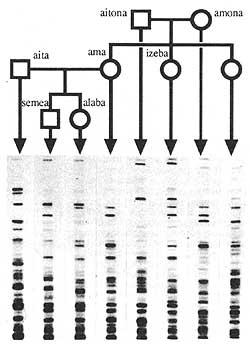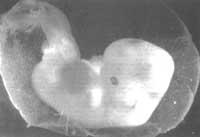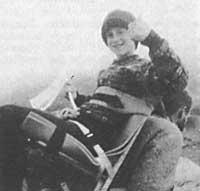Genetic fingerprint
1988/06/01 Juandaburre, B. Iturria: Elhuyar aldizkaria
Organic footprint (hair, seed, blood, etc.) left by the offender in the place of the crime by means of genetic fingerprint once the analysis of the little ones has been carried out, it will be possible to know the author among many suspects. When in a magazine a woman proclaims that Julito or Maradona is the father of her erdite son, genetic fingers will decide. What is the essence of this admirable technique that the offender does not care about wearing gloves and is able to resolve conflicts of fatherhood and motherhood? We will try to answer this question in the following lines.
It is a young technique. He has not yet turned four years old. The father of the child is the British researcher Alec Jeffreys. Jeffreys casually discovered the genes that cause the production of myoglobin (cells that carry oxygen in the tissues). He studied the genetic phenomenon called hypervariable regions. This phenomenon was discovered by American researchers in 1980. The genetic code of DNA is very different in these regions. Except for the identity twin, anyone has a hypervariable region.

The genetic code is based on the four types of bases of the molecular chain of DNA. The sequence of these bases marks the difference between species and the difference between individuals within a species.
Hypermodifiable regions are formed by short sequences of DNA that are repeated on many occasions. The variability of these regions is based on the number of repetitions of each sequence.
In 1984, Jeffreys identified the main sequences of hypervariable regions. These have between 10 and 15 bases and are repeated in many hypervariables. Finding an immutable part in hypermodifiable regions, he found a genetic marker of hypermodifiable. Jeffreys isolated two main DNA sequences and cloned them to get large amounts of markers. Marking the marker with radioactive chemical compounds allowed identifying this sequence in any hypermodifiable region. It can be said that Jeffreys managed to identify the presence of hypervariables.
The test, prepared by Jeffreys, was tested in a large family that knew family relationships. He wanted to show that the test served to determine family relationships, what and what relationship he had. For this, the test locates and marks hypervariable regions. These appear in the form of dark bands in a gel (see figure). The distribution of the bands is characteristic of a grain and is inherited. Approximately half of the bands come from the biological father and the other half from the biological mother.
Jeffreys found that his test could determine the family tree.
As soon as the British Forensic Service knew this technique, it discovered the influence it could have to facilitate the work of forensic doctors. ; for example, applying the test to the seeds found in the vagina of a raped woman. You can certainly decide what has been the rapist of a group of suspects. The same can be done by analyzing the murderer's butts that have been found on the deceased's nails. Genetic traces have been born.
Genetic fingers do not fail and accurately identify the owner. They have already been used as decisive evidence in trials in Britain. In a trial held last November, a rapist was sentenced to genetic marks. Genetic fingers are not just for criminals.
It offers the simplest and fastest solution to maternity and paternity problems. We bring an example. Britain is a strict immigration legislation and, among other means, the easiest way for anyone who wants to emigrate to Britain is to prove that he is the relative of a person living there. That is difficult to prove and sometimes impossible. Genetic fingerprints have already decided a case like this. Born in Britain but emigrated as a child to Ghana with his father, he wished to return to England with his mother. However, since immigration they did not want to give him permission claiming that he was not a child of the woman. Alec Jeffreys examines the blood of her mother, her two sisters and the child who lived in Britain. It extracts DNA from white blood cells and breaks it with enzymes in small portions.
The different parts were separated by an electric field and fixed on a nylon membrane (the small parts distance more through the membrane than the long ones). The next step was to test these DNA fragments to identify and mark the hypervariable regions of DNA. The regions appeared in the form of dark bands in nylon membrane. The evidence claimed that the boy had half of his hyper-changing region as did the girls and his mother. It was clear that the child was his son and the immigrants had to accept him.
Although we only start using genetic fingers, it can be predicted that it can have a rather complicated future. The future will not be just problem solving. The British firm ICI, with the patent of the technique, can be a big business.

Gai honi buruzko eduki gehiago
Elhuyarrek garatutako teknologia





